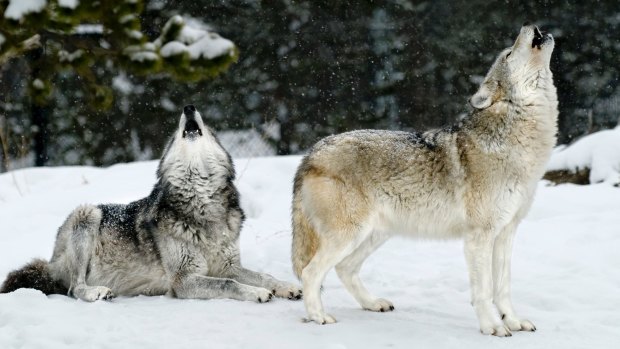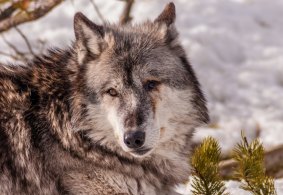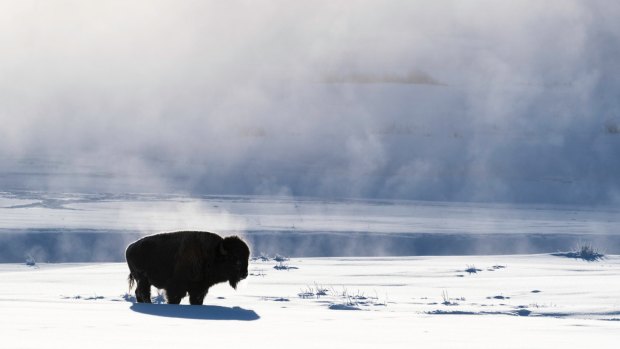
Wolves in Yellowstone.Credit: iStock
I've been in Bozeman, Montana, less than an hour when I decide to catch an Uber from my hotel to downtown. En route, my driver, a burly character who might have walked straight off the set of Ice Road Truckers, asks what brings me to town.
"I've come to find wolves," I say.
"To shoot?"

Grey wolves were re-introduced to Yellowstone National Park to try to rebalance an increasingly skewed ecosystem.Credit: iStock
"Yes. With my camera."
"You ask me they should never have brought 'em back. Did you know wolves are one of the only species that kills just for sport? Oh, yeah. They'll slaughter whole herds of livestock just for the fun of it."
A few days later a group of us are piling into a van on the outskirts of Yellowstone National Park. It's 5.30am, pitch dark; cold enough to freeze the fillings out of your teeth. Our driver and guide is Tim Wenzel, a thirtysomething adventurer with a rapier wit and chest length beard, like an extreme sports version of Gandalf.

A bison in the mist of Lamar Valley in Yellowstone National Park, Wyoming during winter. Credit: iStock
No one says much given the unsociable hour. There's a smell of coffee, bloodshot eyes, people wrestling into their seats wearing enough layers of winter gear to turn the tiniest specimen into the Michelin Man.
Firing up the engine, Wenzel lurches us out of the car park and we tear down the icy highway towards one of the park's five entrances 65 kilometres south.
Yellowstone is the world's first National Park. Established in 1872 by the US Congress, it spans the states of Wyoming, Idaho and Montana and contains the highest concentration of geothermal activity in the world.
But there's another reason it's gained notoriety in more recent times.
Throughout the1920s, wolves were hunted to extinction here as part of a program by Congress to help protect elk populations. Then in 1995 one of the world's most ambitious biological projects saw grey wolves re-introduced from Canada to try to rebalance an increasingly skewed ecosystem.
On the outskirts of the park we stop to pick up Evan Stout, a guide and naturalist whose aim is to help us track them down. Dressed in an orange puffer jacket, his thick beard and frozen hair protruding from beneath a worn trucker's cap, he offers a refreshingly restrained greeting before taking a seat shotgun beside Wenzel. I soon nod back into a fitful slumber but my reverie is halted as Wenzel slams on the breaks.
"There!" someone shouts from up front. Somewhere in the inky blue dawn, two distinct shadows dart across our path. There is pandemonium. In a flash, Stout is outside, frantically scanning the horizon with binoculars. People struggle into jackets, fumble with cameras or jostle to exit the truck.
Outside it's so cold it burns. Somehow, in the few moments it has taken me to get organised, Stout has pointed 10 high powered viewing scopes at the horizon. Pressing my eye against one, I'm stunned. There, magnified and framed in a perfect sphere, a pair of wolves sit on the ridge of a snowy knoll, howling in unison at the encroaching daybreak.
There's a buzz in the van afterward, our collective fatigue banished as darkness gives way to a sun burning amber through the haze of a northern sky.
Though Yellowstone is one of the world's best places to see wolves in the wild, our encounter is still remarkable given the harsh reality of life for these animals.
As of January 2017, there were an estimated 108 wolves living primarily in Yellowstone Park and about 300 living within the greater Yellowstone ecosystem. And while they are protected under federal law within the park, should they cross the invisible boundary line, they are liable to be, and frequently are, shot dead.
Life for wolves is hard. The average lifespan within Yellowstone is four to five years but only two to three outside. Most deaths within the boundary are caused either by other wolves or by their own prey during attempted kills; taking down a creature three times your size using only your teeth is a risky business. Outside the park, most succumb to trigger-happy humans.
We continue eastward from Little America deeper into the valley, the meandering Lamar River skirting our path. It's truly a winter wonderland, sprawling snowy plains punctuated by pockets of frozen pines, thermal estuaries slicing an erratic route, herds of bison foraging for food. In winter, the park is practically devoid of people. Only a single road between Mammoth (north entrance) and Cooke City (north-east entrance) remains open to most vehicles between November and April and most tourists will take the perceived easier option of a summer visit. But now there is an almost dreamlike feel. There's a rare silence, a sense of solitude; bald eagles hover above, big horn sheep graze on sheer hillsides, bison and elk traverse the land, even a moose meanders languidly across our path.
As the day wears on, Stout's knowledge and passion for wolves becomes increasingly evident. We learn of the complex nature of pack dynamics, hear tragic stories of alphas forced into exile and discover the potential pitfalls of anthropomorphising such an intricate apex predator.
Most scientists see the re-introduction project as one of the great biological success stories of the modern era. With the top predator now restored, elk numbers are back under control, vital areas have regenerated; plants such as young willow, aspen and cottonwood are flourishing again, allowing beaver colonies to recover, there's a massive snowball effect.
But the project has, and likely will always have its detractors. Some are local livestock owners who understandably fear the slaughter of their livelihood. Then there are trophy hunters or those who simply misunderstand wolves as mindless killers.
I relay my conversation with the Uber driver past Stout.
"Wolves have for centuries been believed to be 'sport hunters'," he says.
"This is simply not true. Though wolves will occasionally carry out what is known as a 'surplus killing' – meaning they will kill more prey than they could consume at one time – this only happens in the rarest conditions when they have the greatest advantage.
"Without human intervention, wolves will frequently return to feed on their kill but occasionally, it's tampered with for propaganda purposes which detracts wolves from returning. Ultimately, this not only fosters an unnecessary culture of fear, but also ensures the prey was killed in vain."
Our drive culminates at Cooke City, a former gold mining town in the north-east section of the park. It has an eerily subdued feel, the (mostly shut for winter) businesses and hotels buried under metres of snow. On a rooftop, I watch a man shovelling the remnants of a blizzard from beside a chimney belching smoke into the crisp air.
On the drive home, the wolves remain elusive. Perhaps fittingly, they have allowed us just the merest glimpse into their convoluted world before disappearing again to continue their perpetual battle for survival.
But I'm haunted by what I've seen, what I've learned, my perception of the wilderness and its importance shifted irrevocably in the space of a single day.
As preeminent nature writer Gary Ferguson wrote in his book, Decade of the Wolf: "In the end, we must understand that if these last wild places disappear, then the part of us those places have given fire to, will in time, disappear as well."
TRIP NOTES
MORE
FLY
Virgin Airlines operates frequent direct flights from Sydney to Los Angeles with ongoing connections to Bozeman via Salt Lake City. See virginamerica.com
TOUR
Grand American Adventures offers a seven-day, Yellowstone Winter Wildlife tour. Trip includes five lodge nights and one hotel night, professional tour leader and local guides, private vehicle and snow coach. Maximum group size 13 beginning and ending in Bozeman. Tour starts from $3989. Departure dates January 8, 2018, and January 29, 2018. See grandamericanadventures.com
STAY
The C'mon Inn offers comfortable lodgings close to downtown Bozeman, Montana. Rooms from $US110 a night. See cmoninn.com
Chico Hot Springs Resort offers cabins and hotel rooms in the foothills of the Absaroka Mountain Range on the outskirts of Yellowstone National Park. The property features natural hot spring pools on site. Rooms from $US71 a night. See chicohotsprings.com
Old Faithful Snow Lodge offers cabins and lodge rooms in the Old Faithful region of Yellowstone National Park. Frontier cabins from $US151, premium lodge rooms from $US305. See yellowstonenationalparklodges.com
Guy Wilkinson was a guest of Grand American Adventures
FIVE MORE YELLOWSTONE HIGHLIGHTS
MAKE TRACKS
The Old Faithful region has the world's highest concentration of geothermal activity and there's no better way to experience it up close and personal than on skis or snowshoes.
RIDE A SNOW COACH
In winter, the Old Faithful Snow Lodge can only be accessed by a singular snow highway traversed by custom-built snow coaches. The transfer involves stop-offs at waterfalls, geysers, lookout points and more.
WATCH OLD FAITHFUL
This geyser erupts every 60-110 minutes, hence the moniker. During eruptions, as much as 32,000 litres of water can be spewed at high velocity 45 metres into the air for up to five minutes.
GO BACK IN TIME
Peruse an outstanding collection of photographs, films and exhibits at the Yellowstone Historic Centre, detailing the history of the area from the earliest pioneers. See yellowstonehistoriccenter.org
TAKE A HOT SOAK
Even with the temperature plunging well below zero, a soak in natural thermal waters at the Chico Hot Springs is a magic way to round off a day of wildlife viewing in the park. See chicohotsprings.com
Sign up for the Traveller Deals newsletter
Get exclusive travel deals delivered straight to your inbox. Sign up now.